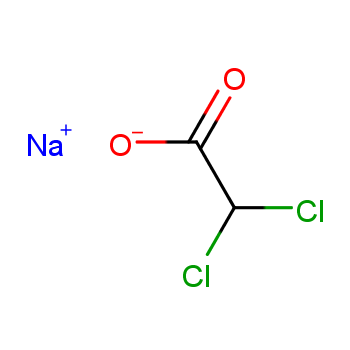 |
 |
Acetic acid, 2,2-dichloro-, sodium salt (1:1) ACETIC ACID,DICHLORO-,SODIUM SALT Cpc 211 dichloroacetate de sodium dichloroacetate sodium salt dichloroacetate,sodiumsalt dichloroacetic acid sodium salt dichloro-aceticacisodiumsalt Dichloroctan sodny [Czech] dichloroctansodny EINECS 218-461-3 erlcyiuanna MFCD00070489 NATRIUMDICHLORACETAT SDA Sodium 2,2-dichloroacetate Sodium dichloroacetate [USAN] sodium dichlroacetate sodium salt of dichloroacetate Sodiumdichloracetate
The Sodium dichloroacetate, with the cas register number 2156-56-1, has its IUPAC name of sodium 2,2-dichloroacetate. This is a kind of white powder, and is soluble in cold water.
The characteristics of this chemical are as below: (1)H-Bond Acceptor: 2; (2)Rotatable Bond Count: 1; (3)Exact Mass: 149.925129; (4)MonoIsotopic Mass: 149.925129; (5)Topological Polar Surface Area: 40.1; (6)Heavy Atom Count: 7; (7)Formal Charge: 0; (8)Complexity: 64.7; (9)Covalently-Bonded Unit Count: 2.
Uses of Sodium dichloroacetate: Sodium dichloroacetate could react with ethane-1,2-diamine and 4-bromo-phenol to produce dibromo N,N'-ethylenebis[2-(o-hydroxyphenyl)glycines]. The reaction condition is below: reagent: 6 N NaOH; solution:H2O, methanol; reaction time: 24 hours; reaction temp.: 85 ℃; field: 30%.
You should be cautious while dealing with this chemical. Being a kind of irritant chemical, it is irritating to eyes, respiratory system and skin and may cause inflammation to the skin or other mucous membranes. So while using this, you should take the following instructions. Wear suitable protective clothing, gloves and eye/face protection, and if in case of contacting with eyes, rinse immediately with plenty of water and seek medical advice.
The following datas could be converted into the molecular structure:
(1)Canonical SMILES: C(C(=O)[O-])(Cl)Cl.[Na+]
(2)InChI: InChI=1S/C2H2Cl2O2.Na/c3-1(4)2(5)6;/h1H,(H,5,6);/q;+1/p-1?
(3)InChIKey: LUPNKHXLFSSUGS-UHFFFAOYSA-M?
Below are the toxicity information which have been tested:
Organism
Test Type
Route
Reported Dose (Normalized Dose)
Effect
Source
mouse
LD50
intraperitoneal
> 3gm/kg (3000mg/kg)
?
Journal of Agricultural and Food Chemistry. Vol. 10, Pg. 370, 1962.
mouse
LD50
oral
4845mg/kg (4845mg/kg)
?
Journal of Pharmacology and Experimental Therapeutics. Vol. 222, Pg. 501, 1982.
?
rat
LD50
oral
5281mg/kg (5281mg/kg)
?
Journal of Industrial Hygiene and Toxicology. Vol. 23, Pg. 78, 1941.
Not classified.
| Pictogram(s) | No symbol. |
|---|---|
| Signal word | No signal word. |
| Hazard statement(s) | none |
| Precautionary statement(s) | |
| Prevention | none |
| Response | none |
| Storage | none |
| Disposal | none |
none
Sodium dichloroacetate (DCA) is a mitochondrial pyruvate dehydrogenase kinase inhibitor, and is an orally absorbable small molecular compound for MELAS syndrome, and children with congenital lactic acidosis and other diseases that are treated in the clinic. Recent studies had found that DCA acts as a potential vasoprotective agent by inhibiting PDK2 and reducing coronary endarterium proliferation. Further, DCA promotes brain regeneration after cerebral ischemia, which indicates that DCA might play an important role in VD.